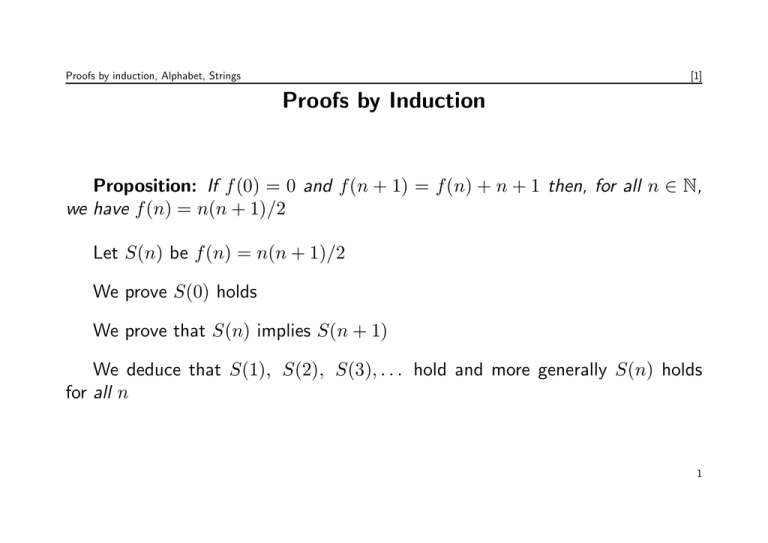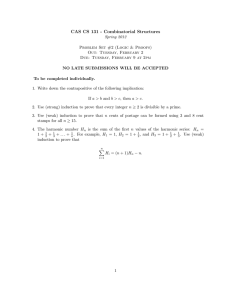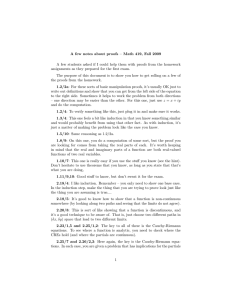Proofs by Induction
advertisement

Proofs by induction, Alphabet, Strings
[1]
Proofs by Induction
Proposition: If f (0) = 0 and f (n + 1) = f (n) + n + 1 then, for all n ∈ N,
we have f (n) = n(n + 1)/2
Let S(n) be f (n) = n(n + 1)/2
We prove S(0) holds
We prove that S(n) implies S(n + 1)
We deduce that S(1), S(2), S(3), . . . hold and more generally S(n) holds
for all n
1
Proofs by induction, Alphabet, Strings
[2]
Proofs by Induction
Proposition: If A ⊆ N and A does not have a least element then A = ∅
Assume that A has no least element
Let S(n) be that, forall a ∈ A we have n < a
We prove S(0) holds: if 0 ∈ A then 0 is the least element of A
We prove that S(n) implies S(n + 1). We assume S(n). If n + 1 ∈ A then
n + 1 is the least element of A
We deduce that S(1), S(2), S(3), . . . hold and more generally S(n) holds
for all n. This implies A = ∅
Any nonempty subset of N has a least element
2
Proofs by induction, Alphabet, Strings
[3]
Proofs by Induction
Proposition: If n ≥ 8 then n can be written as a sum of 3’s and 5’s
Let S(n) be “n can be written as a sum of 3’s and 5’s”.
S(7) does not hold. But S(8), S(9), S(10) hold.
Let T (n) be “S(k) hold for k = 8, 9, . . . , n”
We prove T (n) ⇒ T (n + 1) for n ≥ 10
If T (n) holds then S(n − 2) holds and so does S(n + 1).
3
Proofs by induction, Alphabet, Strings
[4]
Proofs by Induction
All horses have the same color
P (n): for any set of n horses they are all of the same color
P (1) is clearly true
We claim that P (n) implies P (n + 1)
Take h1, . . . , hn they are all of the same color
Also h2, . . . , hn+1. Hence h1, . . . , hn+1 all have the same color!
4
Proofs by induction, Alphabet, Strings
[5]
Proof by Mutual Induction
One can represent a circuit as a set of functions from natural numbers to
{0, 1} defined recursively
For instance
f (0) = 0, g(0) = 1, h(0) = 0
f (n + 1) = g(n), g(n + 1) = f (n), h(n + 1) = 1 − h(n)
Proposition: We have h(n) = f (n) for all n
If S(n) is h(n) = f (n) it does not seem possible to prove S(n) ⇒ S(n + 1)
directly
5
Proofs by induction, Alphabet, Strings
[6]
Proof by Mutual Induction
We prove, by induction on n the statement T (n)
h(n) = f (n) ∧ h(n) = 1 − g(n)
BASIS: h(0) = f (0) ∧ h(0) = 1 − g(0)
STEP: T (n) ⇒ T (n + 1)
One needs to strengthen the statement S(n) to the statement T (n)
6
Proofs by induction, Alphabet, Strings
[7]
Proof by Mutual Induction
This can be represented as a state machine
The states are the possible values of s(n) = (f (n), g(n), h(n))
The transitions are from the states s(n) to the state s(n + 1)
One can check the invariant f (n) = h(n) on all the states accessible from the
initial state (0, 1, 0).
7
Proofs by induction, Alphabet, Strings
[8]
Proofs by Induction
In mathematics, this is almost the only form of induction that is used
In computer science, proofs by induction play a more important rôle
Other data types than natural numbers: lists, trees, . . .
Notion of inductively defined sets (that we shall see later in the course)
8
Proofs by induction, Alphabet, Strings
[9]
Other data types
Finitely branching trees
Basis: the empty tree () is a tree
Inductive step: if we have a finite list of trees t1, . . . , tk we can form a new
tree (t1, . . . , tk )
We can then define functions on the set of trees by induction, and prove
properties of these functions by induction
9
Proofs by induction, Alphabet, Strings
[10]
Other data types
We can represent graphically the trees like in 1.4.3 and define the functions
ne(t) (number of edges) and nn(t) (number of nodes)
ne() = 0, ne(t1, . . . , tk ) = k + ne(t1) + · · · + ne(tk )
nn() = 1, nn(t1, . . . , tk ) = 1 + nn(t1) + · · · + nn(tk )
Proposition: for all tree t we have nn(t) = 1 + ne(t)
Proof by induction with Basis case and Inductive step case
10
Proofs by induction, Alphabet, Strings
[11]
Other example
We define the function
rev() = (), rev(t1, . . . , tk ) = (rev(tk ), . . . , rev(t1))
Proposition: for all tree t we have rev(rev(t)) = t
We prove
Basis: P ()
Inductive step: P (t1, . . . , tk ) follow from P (t1), . . . , P (tk )
11
Proofs by induction, Alphabet, Strings
[12]
Other data types
Abstract syntax of a language
Arithmetical expression E
Basis: if n natural number then n ∈ E
Inductive step: if e1, e2 ∈ E then minus(e1), plus(e1, e2), times(e1, e2) ∈ E
We can then define the semantics of an arithmetical expression by induction
s(n) = n, s(minus(e)) = −s(e),
s(e2), s(times(e1, e2)) = s(e1) × s(e2)
s(plus(e1, e2))
=
s(e1) +
12
Proofs by induction, Alphabet, Strings
[13]
Central concepts: alphabet and words
Σ given finite set
Alphabet finite set of symbols (events) Σ
String (or word, or trace: finite sequence of symbols (behaviour)
type convention: a, b, c, . . . for symbols (events) and x, y, z, . . . for strings
(words)
13
Proofs by induction, Alphabet, Strings
[14]
Words
Σ∗ is the set of all words for a given alphabet Σ
This can be described inductively in at least two different ways
Basis: the empty word is in Σ∗
Inductive step: if a ∈ Σ and x ∈ Σ∗ then ax ∈ Σ∗
14
Proofs by induction, Alphabet, Strings
[15]
Words
The other description is
Basis: the empty word is in Σ∗
Inductive step: if a ∈ Σ and x ∈ Σ∗ then xa ∈ Σ∗
We can define functions and prove properties of these functions by induction
15
Proofs by induction, Alphabet, Strings
[16]
Length
The length function is defined by
Basis: || = 0
Inductive step |ax| = 1 + |x|
|p0p1p0p0p1| = 5
16
Proofs by induction, Alphabet, Strings
[17]
Concatenation
The concatenation function xy is defined by
Basis: y = y
Inductive step: (ax)y = a(xy)
Proposition: for all x, y we have |xy| = |x| + |y|
Example: if x = p0p1 and y = p0p0p1 then
xy = p0p1p0p0p1 and yx = p0p0p1p0p1
In general xy 6= yx: concatenation is not commutative
17
Proofs by induction, Alphabet, Strings
[18]
Concatenation
Proposition: for all x we have x = x = x
Proposition: for all x, y, z we have x(yz) = (xy)z
We write it simply xyz
18
Proofs by induction, Alphabet, Strings
[19]
Power
We define xn by
x0 = and xn+1 = xnx
We define it by induction on n
For instance (p0p1)3 = p0p1p0p1p0p1
19
Proofs by induction, Alphabet, Strings
[20]
Languages
Given an alphabet Σ
A language is simply a subset of Σ∗
Common languages, programming languages, can be seen as sets of words
A language can be finite or infinite
20
Proofs by induction, Alphabet, Strings
[21]
Reverse functions
Intuitively rev(a1 . . . an) = an . . . a1
We can define rev(x) by induction
rev() = rev(ax) = rev(x)a
Lemma: rev(xy) = rev(y)rev(x)
21
Proofs by induction, Alphabet, Strings
[22]
Some terminology
x is a prefix of y iff there exists z such that y = xz
x is a suffix of y iff there exists z such that y = zx
x is a palindrome iff x = rev(x)
22
Proofs by induction, Alphabet, Strings
[23]
A proof by induction
Proposition: If x = z k and y = z l then xy = yx = z k+l
Theorem: We have xy = yx iff there exists z, k, l such that x = z k and
y = zl
Exercice: What are the words x such that there exists y such that x3 = y 2
23
Proofs by induction, Alphabet, Strings
[24]
Function bewteen languages
We consider functions f : Σ∗ → Θ∗ such that
f () = f (xy) = f (x)f (y)
If x = a1 . . . ak we have f (x) = f (a1) . . . f (ak )
Such a function f is a coding iff f is injective
Example: file compression
24



